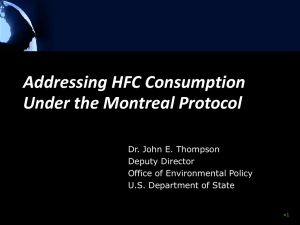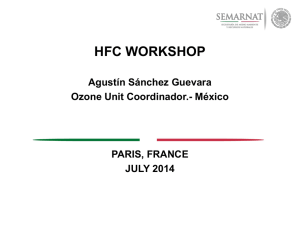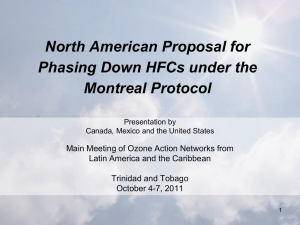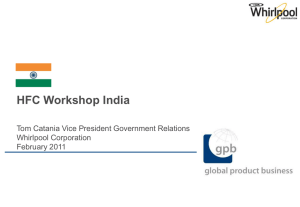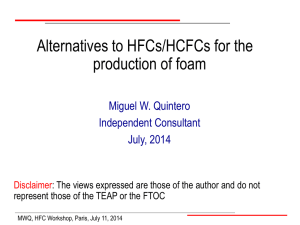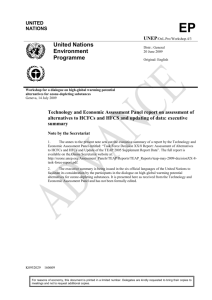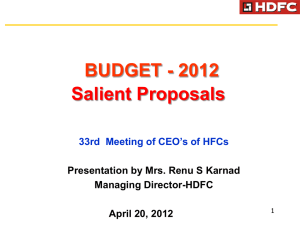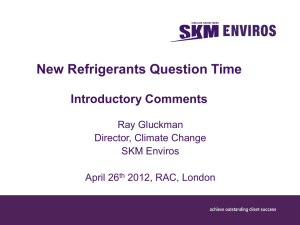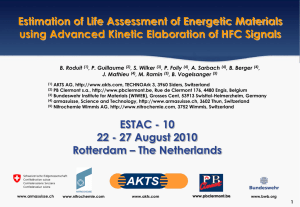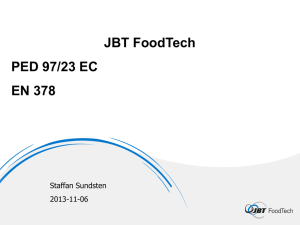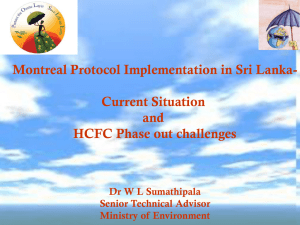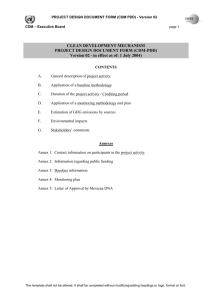U.S. Stakeholder Meeting on Montreal Protocol HFC Initiatives
advertisement
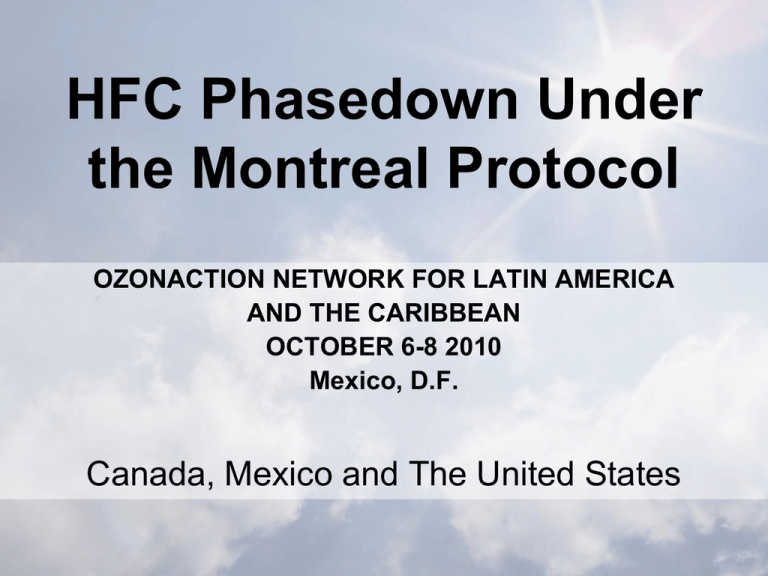
HFC Phasedown Under the Montreal Protocol OZONACTION NETWORK FOR LATIN AMERICA AND THE CARIBBEAN OCTOBER 6-8 2010 Mexico, D.F. Canada, Mexico and The United States Scope of Presentation • • • • • • • • Trilateral Amendment Proposal Overview Legal Aspects Policy Rationale Comparisons Benefits Financial Assistance Path Forward HFC-23 By-Product Emissions From HCFC-22 Production • Questions and Comments Trilateral Amendment Proposal • Canada, Mexico & United States Proposal – Phasedown, not Phaseout of HFCs • Phases Down to 15% of Baseline – Phasedown is GWP-Weighted – Covers 20 HFCs, Including 2 known as HFOs – Limits By-Product Emissions of HFC-23 – Leaves UNFCCC Obligations Unchanged • Supports Global Efforts to Reduce GHGs – MLF eligibility for Production & Consumption and HFC-23 By-Product Reductions Montreal Protocol has Mandate with respect to HFCs • Vienna Convention Article 2 provides scope to address HFCs – HFCs result in adverse effects resulting from ozone layer protection, so Parties can harmonize approaches to reduce impacts • Trilateral HFC proposal includes provisions confirming obligations relating to HFC emissions continue unchanged under UNFCCC/Kyoto Protocol – Complements but does not replace existing UNFCCC obligations – Addresses consumption and production to assist in reductions of emissions – Similar to aviation and maritime bunker emissions to be addressed by ICAO and IMO Mandate of Montreal Protocol with Respect to HFCs: Policy Aspects (1) • Given HFC growth results from ODS phaseout, Montreal Protocol has special responsibility to address HFCs • Montreal Protocol has long history of concern with HFCs: – MOP Decision X/16 (1998): convened workshop, in collaboration with UNFCCC, with view to assisting establishment of information on HFCs and PFCs and potential ways to limit their emissions – MOP Decision XIV/10 (2002): called on TEAP to collaborate with IPCC to develop report: Safeguarding the Ozone Layer and the Global Climate System; Issues Related to HFCs and PFCs – MOP Decision XX/8 (2008): called for report and workshop on high-GWP alternatives, principally HFCs, to ODS – ExCom Decision 60/44 (2010): allows for 25% funding increment, above cost-effectiveness thresholds, when needed for climate benefits, mainly to avoid selection of high-GWP HFCs Mandate of Montreal Protocol with Respect to HFCs: Policy Aspects (2) • While Montreal Protocol has not controlled HFCs, historically, it has taken key steps developing information and understanding on HFC use and emissions at global level • Montreal Protocol has built world’s widest body of experience and expertise on sectors using HFCs • Therefore, it is not only appropriate, but incumbent on Montreal Protocol to take action on HFCs – In collaboration with UNFCCC/Kyoto Protocol • Ultimately, atmosphere will not care if HFCs have been reduced through Montreal Protocol, UNFCCC/Kyoto Protocol or both Trilateral Proposal Phasedown Schedule 100% 90% 90% Non-A5 Reduction Steps 80% 80% Cap - Percent of Baseline 90% 80% A5 Reduction Steps 70% 70% 70% 60% 50% 50% 50% 40% 30% 30% 30% 20% 15% 15% 10% 0% 2010 2015 2020 2025 2030 Years 2035 2040 2045 2050 Federated States of Micronesia HFC Amendment Proposal: Differences • A5 Country baseline established with different methodology – Article 5 average 2007-2009 HCFC • Schedule differs – Reductions every 3 years until 2028, then plateau established in 2030 – Plateaus at 10% of baseline – Includes by-product control provisions starting in 2013 Proposed HFC Reduction Steps for Article 5 and Non-Article 5 Countries 100% 90% Canada, Mexico & United States (Non-A5) 90% 85% 85% 80% 80% Cap - Percent of Baseline Canada, Mexico & United States (A5) 90% 70% 70% 60% Federated States of Micronesia (Non-A5) 80% 70% 70% 55% Federated States of Micronesia (A5)* 70% 55% 50% 50% 45% 50% 45% 40% 30% 30% 20% 15% 30% 15% 30% 15% 10% 10% 0% 2010 30% 2015 2020 2025 2030 15% 10% 2035 2040 2045 * Baseline = Average HCFC Consumption, 2007-2009 (all others Average HCFC+HFC, 2004-2006) 2050 Overview of HFC Proposals Trilateral Proposal Non-A5 Schedule Micronesia Proposal A5 Schedule Non-A5 Schedule A5 Schedule Year Cap Year Cap Year Cap Year Cap 2014 90% 2017 90% 2013 85% 2019 85% 2017 80% 2021 80% 2016 70% 2022 70% 2020 70% 2025 70% 2019 55% 2025 55% 2025 50% 2029 50% 2022 45% 2028 45% 2029 30% 2035 30% 2025 30% 2031 30% 2033 15% 2043 15% 2028 15% 2034 15% Plateau 15% Plateau 15% 2030 10% 2036 10% Plateau 10% Plateau 10% Non-A5 Baseline A5 Baseline Non-A5 Baseline A5 Baseline HFC+HCFC from 2004-2006 HFC+HCFC from 2004-2006 HFC+HCFC from 2004-2006 HCFC from 2007-2009 Non-Article 5 Parties Estimated HFC Consumption & Benefits from Phase Down 1,200 Projected HFC Consumption First Effective Year of Consumption Cap 1,000 Climate Benefits 600 90% of Baseline HFC MMTCO2E 800 80% of Baseline 200 HCFC 400 First Compliance Obligation BASELINE 2009 2010 2010 2011 2012 2013 2014 2014 2015 2016 2017 2018 YEAR HCFC Consumption HFC Consumption HFC Projected Consumption North American Proposed Schedule HFC BENEFITS 2019 2020 Estimated First Effective Year of Proposed Phase Down for Article 5 Parties First Effective Year of Consumption Cap 900 800 700 90% of Baseline 400 HCFC 500 First Compliance Obligation 300 200 100 Projected HFC Consumption HFC MMTCO2E 600 BASELINE 2009 2010 2011 2012 2013 2014 YEAR 2015 2016 2017 2017 2018 2018 2019 2020 HFC Consumption HCFC Consumption HFC Projected Consumption North American Proposed Schedule Linear (Step Down Schedule) Substantial Climate Benefits • Global Trilateral Proposal Cumulative Benefits: – ~3,000 MMTCO2eq* through 2020 • Non-Article 5 Parties = 3,000 MMTCO2eq • Article 5 Parties = 150 MMTCO2eq – ~88,000 MMTCO2eq through 2050 • Non-Article 5 Parties = 43,000 MMTCO2eq • Article 5 Parties = 45,000 MMTCO2eq • FSM Proposal cumulative benefits: – ~4,000 MMTCO2eq through 2020 – ~93,000 MMTCO2eq through 2050 • EPA’s Analysis of HFC Production and Consumption Controls: http://www.epa.gov/ozone/downloads/Analysis_of_HFC_Production_and_C onsumption_Controls.pdf *MtCO2eq Trilateral Proposal Benefits in Context consumption reductions emission reductions emissions 100,000 90,000 MMTCO2eq 80,000 70,000 60,000 50,000 40,000 30,000 20,000 10,000 0 North American Micronesia Montreal Proposal (2014- Proposal (2013- Protocol (19902050) 2050) 2010) Accelerated HCFC Phaseout (2010-2039) Kyoto Protocol (2008-2012) Copenhagen Accord (20122020) Annex I Emissions in 2007 Financial Assistance to Article 5 Parties • Ensure timely financial assistance through MLF to address HFCs before huge growth takes place – Waiting longer makes it more difficult and costly to phase down HFCs see HCFC challenge – Waiting also increases damage to climate system • Effective incremental cost model of MLF can address HFCs – Many countries indicated preference for MLF model in various international environmental forums and negotiations • Allows short-term HFC growth to replace HCFCs when no other cost-effective alternatives are available • Most Article 5 countries would not actually need to reduce HFC consumption or production until 2018 at earliest – Recognizes short-term focus must be on HCFC phase-out HFC-23 By-Product Emissions • Background: – HFC-23 is a by-product of producing HCFC-22 – HFC-23 has highest GWP of all HFCs – Controlled HFC-23 emissions are decreasing but uncontrolled HFC-23 emissions are increasing, in Article 5 Countries (Montzka, et al) – CDM projects cover <50% HFC-23 emissions in Article 5 Parties • Amendment Controls By-Product Emissions – Covers Emissions from HCFC-22 Production Facilities – Makes By-Product Obligations Eligible for MLF Funding • Would cover facilities not covered by CDM – Additional Benefits from HFC-23 Mitigation ~6,000 MMTCO2eq by 2050 Separate Decision on HFC-23 By-Product Emissions • Recognizes HFC emissions covered by Kyoto Protocol to UNFCCC • Requests ExCom of MLF to: – Update Information on Article 5 HCFC-22 Facilities, Including whether CDM-Covered – Develop Capital & Operational Cost Estimates – Formulate Guidelines by 64th ExCom Meeting – Facilitate Implementation of Projects • Request TEAP/SAP to: – Study Costs and Environmental Benefits Summary • HFC amendment proposals provide meaningful real opportunities for near-term climate benefits • Montreal Protocol appropriate vehicle for HFC Phasedown amendment – Successful experience – Effective financial mechanism – Sector expertise – HFCs used tied to ODS phaseout
